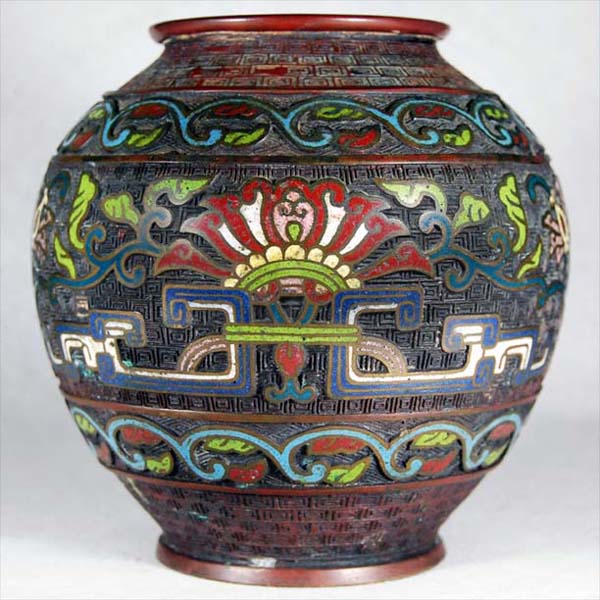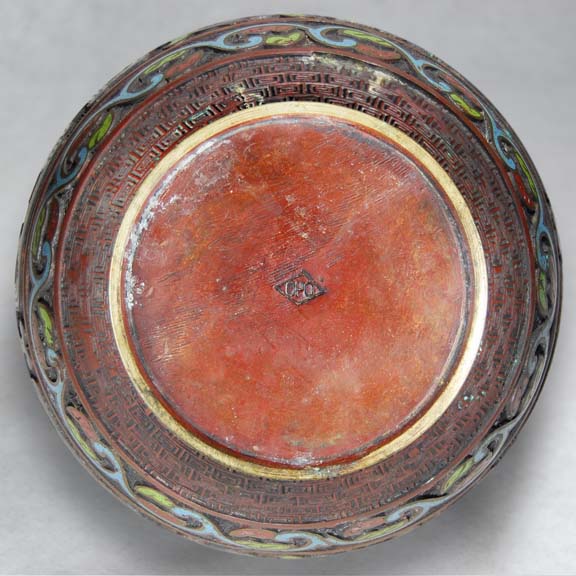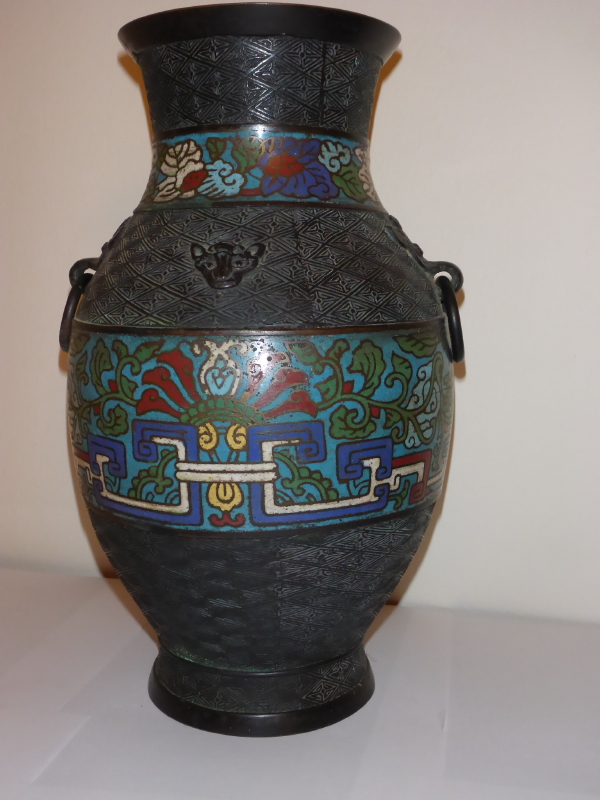
|
Subject:Can anyone help identify my Chinese Cloisonne and Bronze Vase?
Posted By: Bill H Sun, Jan 18, 2015
I dropped by the shop where I'd seen the CPO vase, found it marked half-off so bought it for my archival collection. Here are a couple of pictures.
The CPO item is similar to Steve's in the motif and other characteristics that I associate with later Japanese champlevé vases of this type. They all appear to be fabricated of several pieces that are soldered together. Parts that were put together with acid-based solder show traces of it as they age through localized accumulations of light green or gray patina where the acid was present.
Manufacturing seams are present in some of the fret-type motifs, such as seen in Steve's final photo above, where there is a mismatch in the lozenge fret at its overlaps. This would not be an issue in an antique metal piece cast by the lost-wax (cire perdue) process, which involves creating a wax sculpture in the round to make a mold.
As mentioned earlier, the bases tend to be thin and often are spot-soldered to facilitate easy removal for lamp conversion.
Japanese metal castings of any age almost always seem to have an artificial patina or patinas, the creation of which colors on metal has become much an art form.
Best regards,
Bill H.




|
 Can anyone help identify my Chinese Cloisonne and Bronze Vase?
Can anyone help identify my Chinese Cloisonne and Bronze Vase?  ( China & Japan ) - Steve - Jan 15, 2015 (10:56 PM)
( China & Japan ) - Steve - Jan 15, 2015 (10:56 PM)  Re: Can anyone help identify my Chinese Cloisonne and Bronze Vase? - Bill H - Jan 16, 2015 (01:26 AM)
Re: Can anyone help identify my Chinese Cloisonne and Bronze Vase? - Bill H - Jan 16, 2015 (01:26 AM)  Re: Can anyone help identify my Chinese Cloisonne and Bronze Vase? - Steve - Jan 17, 2015 (10:19 AM)
Re: Can anyone help identify my Chinese Cloisonne and Bronze Vase? - Steve - Jan 17, 2015 (10:19 AM)  1933 N. Shure Co., Chicago, catalog page - beadiste - Jan 16, 2015 (03:54 PM)
1933 N. Shure Co., Chicago, catalog page - beadiste - Jan 16, 2015 (03:54 PM)  Re: 1933 N. Shure Co., Chicago, catalog page - Bill H - Jan 17, 2015 (01:52 AM)
Re: 1933 N. Shure Co., Chicago, catalog page - Bill H - Jan 17, 2015 (01:52 AM)  Re: 1933 N. Shure Co., Chicago, catalog page - Steve - Jan 17, 2015 (10:22 AM)
Re: 1933 N. Shure Co., Chicago, catalog page - Steve - Jan 17, 2015 (10:22 AM)  Can anyone help identify my Chinese Cloisonne and Bronze Vase?
Can anyone help identify my Chinese Cloisonne and Bronze Vase?  - Bill H - Jan 18, 2015 (06:25 PM)
- Bill H - Jan 18, 2015 (06:25 PM)  Re: Can anyone help identify my Chinese Cloisonne and Bronze Vase? - Steve - Jan 19, 2015 (07:28 PM)
Re: Can anyone help identify my Chinese Cloisonne and Bronze Vase? - Steve - Jan 19, 2015 (07:28 PM) .jpg)


